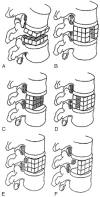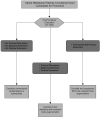Metastatic spinal lesions: state-of-the-art treatment options and future trends
- PMID: 18566009
- PMCID: PMC8118803
- DOI: 10.3174/ajnr.A1137
Metastatic spinal lesions: state-of-the-art treatment options and future trends
Abstract
The purpose of this article is to review the current state of the art for treating symptomatic spinal fractures associated with malignant lesions and to present potential future trends in treatments for this patient population. Epidemiology, clinical presentation, and biomechanical ramifications of these lesions are summarized and treatment regimes, clinical outcomes, and complications and technical issues associated with treatments are presented. Potential future trends and new technologies for performing vertebral body augmentation in patients with metastatic spinal lesions are also discussed.
Figures





References
-
- Krishnaney AA, Steinmetz MP, Benzel EC. Biomechanics of metastatic spine cancer. Neurosurg Clin N Am 2004;15:375–80 - PubMed
-
- Klimo P Jr, Schmidt MH. Surgical management of spinal metastases. Oncologist 2004;9:188–96 - PubMed
-
- Ries LAG, Melbert D, Krapcho M, et al, eds. SEER Cancer Statistics Review, 1975–2005. National Cancer Institute. Bethesda, Md, Available at: http://seer.cancer.gov/csr/1975_2005/, based on November 2007 SEER data submission. Accessed August 7,2007. .
-
- Klimo P, Schmidt MH. Surgical management of spine metastases. Oncologist 2004;9 ;188–96 - PubMed
-
- Dimar JR, Voor MJ, Zhang YM, et al. A human cadaver model for determination of pathologic fracture threshold resulting from tumorous destruction of the vertebral body. Spine 1998;23:1209–14 - PubMed
Publication types
MeSH terms
LinkOut - more resources
Full Text Sources
Other Literature Sources
